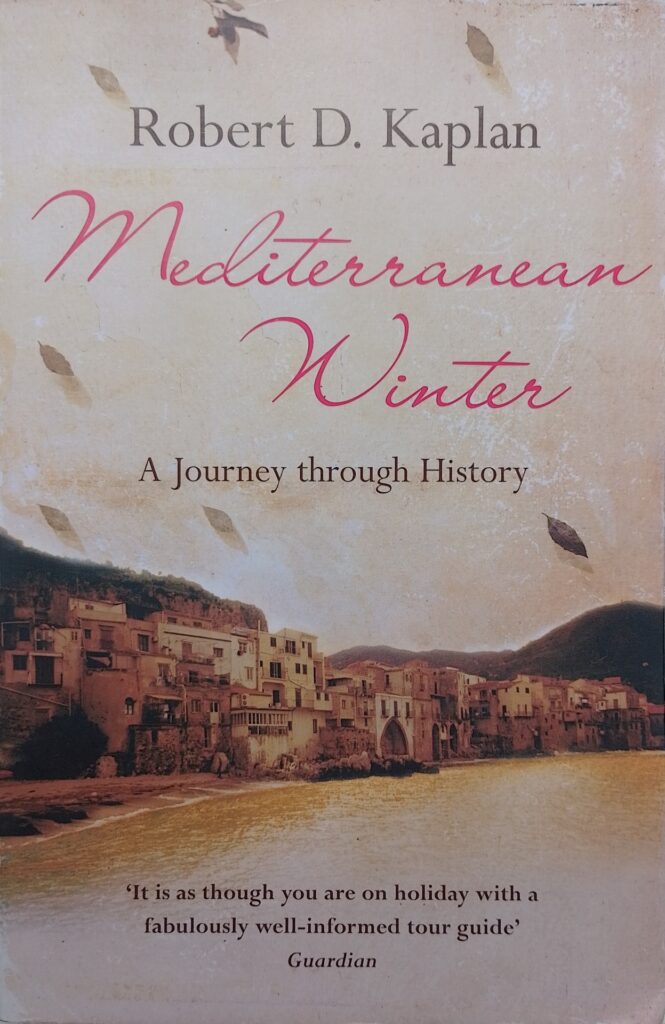First published 2004. Arrow paperback, 2006, pp 254, c.62,000 words.
The great travel writer Patrick Leigh Fermor stands hovering in the background of this journey round the Mediterranean. Like in Fermor’s most read works, it is based on the travels of a very young man, written from the perspective of his much older self. It also attempts to be erudite, frequently referencing great thinkers. It gives us snippets of history, mostly classical, about the places visited, and with almost no intrusion of the mundanities of travel or the people who live in these places today. Kaplan is rather heavy handed with his references: in the first paragraph we are given Rilke’s take on Rodin’s sculpture. We know then that Gide, Rambaud, Montesquieu, St. Augustin and Marcus Aurelius will follow in due course, as they all do, and a host of others from the canon of great European writers.
The journey gets going in Marseilles, but moves swiftly to Tunisia and then on to Sicily, a couple of brief stops in mainland Italy and Croatia and finally ends in Greece. The focus is on the Roman world around the Mediterranean, and how the geography of that sea shaped the classical world in a fundamental way, and both geography and that history are still felt today. In so brief a book, it can hardly be expected to be comprehensive. It is an enticing introduction, with brief descriptions of place intermingled with historical vignettes.
Kaplan occasionally has a lovely turn of phrase, for example: ‘As the sun prowled in and out of sombre clouds’ [p46], ‘Sicily demonstrated that the Mediterranean’s most profound impact upon humanity has been the advancement of art and culture through one civilisation meeting another.’ [p110], and ‘ranks of moss-bearded, dinosauric humps advancing in dreary majesty towards the horizon.’ [p209] (even if I’m not quite convinced by ‘advancing’ in juxtaposition with ‘towards the horizon’.)
Although Kaplan seems to have made his living as a journalist, here he is untrammelled by the need to communicate with a mass audience. He is fond of obscure words such as: ‘pellucid’ [p65], ‘bister’ (as an adjective) [p88], ‘crispated’ [p109], ‘reticulated’ [p147], ‘pullulating’ [p180], ‘chthonic’ [p184], ‘caerulian’ [p188].
Towards the end, Kaplan visits Mount Athos which Fermor describes from a slightly earlier time. The journey then moves to the Peloponnese, and he visits the sites of classical Corinth and Sparta. Finally, we get a big surprise: Kaplan has lunch with Fermor, who for a long time had a house there. The old man seems to be still engaged, full of curiosity and love of intellectual debate, and still working on the final volume of his youthful journey, which sadly remained to be finished by others at his death.
Travelling around the Mediterranean in winter has its advantages. The tourists are all at home, and the antiquities can be viewed in comparative peace. Living there for a poor young man was cheap in the 1970s, and he was able to take the time to get to know places some depth and relate them to their classical past. He could read the histories and other traveller’s experience of places in their context, and he shares his enthusiasms with us.
Kaplan is undoubtedly a knowledgeable guide and gives us sufficient morsels to stimulate our memories of past visits and lessons on the classical world. This is like being taken on a leisurely cruise to interesting places in the company of a very well-informed guide, bubbling over with enthusiasm for his subject.
Wikipedia biography of Kaplan: https://en.wikipedia.org/wiki/Robert_D._Kaplan
Others’ reviews of the book: https://www.goodreads.com/book/show/33686.Mediterranean_Winter?ref=nav_sb_ss_1_20
© William John Graham, April 2024

